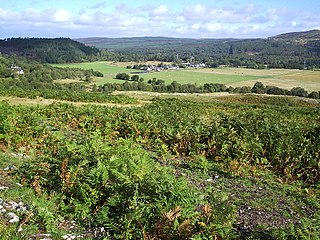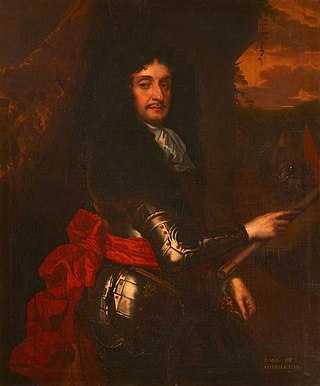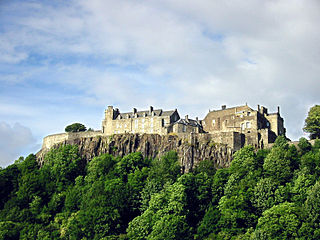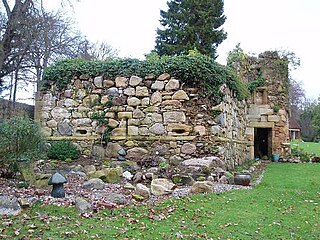Related Research Articles

James Graham, 1st Marquess of Montrose was a Scottish nobleman, poet, soldier and later viceroy and captain general of Scotland. Montrose initially joined the Covenanters in the Wars of the Three Kingdoms, but subsequently supported King Charles I as the English Civil War developed. From 1644 to 1646, and again in 1650, he fought in the civil war in Scotland on behalf of the King. He is referred to as the Great Montrose.
Major General Sir James Holborne of Menstrie was a Scottish soldier during the years of the English Civil War. He eventually reached the rank of Major General and fought with the Parliamentarians during the English Civil War, fighting at Newbury and Taunton. Although he initially fought on the side of the English Parliament, he later became a senior officer in the Scottish Army, fighting against Cromwell. He lived at Menstrie Castle, in Menstrie, Clackmannanshire, central Scotland, which he had purchased in 1649.

David Leslie, 1st Lord Newark was a Scottish military officer and peer. During the Thirty Years' War, he joined in the Swedish Army in 1630 and served under Alexander Leslie. Returning to Scotland in the final days of the Bishops' War, Leslie fought in the English Civil War and Scottish Civil Wars on the side of the Covenanters and Royalists. After the Stuart Restoration, Leslie was raised to the peerage of Scotland as Lord Newark by Charles II of England.

The Battle of Dunbar was fought between the English New Model Army, under Oliver Cromwell, and a Scottish army commanded by David Leslie on 3 September 1650 near Dunbar, Scotland. The battle resulted in a decisive victory for the English. It was the first major battle of the 1650 invasion of Scotland, which was triggered by Scotland's acceptance of Charles II as king of Britain after the beheading of his father, Charles I on 30 January 1649.

Between 1639 and 1652, Scotland was involved in the Wars of the Three Kingdoms, a series of wars starting with the Bishops' Wars, the Irish Rebellion of 1641, the English Civil War, the Irish Confederate Wars, and finally the subjugation of Ireland and Scotland by the English Roundhead New Model Army.

Sir John Urry, also known as Hurry, was a Scottish professional soldier who at various times during the Wars of the Three Kingdoms fought for Scots Covenanters, Engagers and Royalists, as well as both English Parliamentarians and Royalists. Captured at Carbisdale in April 1650, he was executed in Edinburgh on 29 May 1650.

The Battle of Inverkeithing was fought on 20 July 1651 between an English army under John Lambert and a Scottish army led by James Holborne as part of an English invasion of Scotland. The battle was fought near the isthmus of the Ferry Peninsula, to the south of Inverkeithing, after which it is named.

Sir William Lockhart of Lee (1621–1675), was a Scottish soldier and diplomat who fought for the Covenanters during the 1638 to 1651 Wars of the Three Kingdoms. Following Royalist defeat in the 1642 to 1647 First English Civil War, Lockhart took part in negotiations between Charles I and Scottish Engagers, who agreed to restore him to the English throne.

The Battle of Carbisdale took place close to the village of Culrain, Sutherland, Scotland on 27 April 1650 and was part of the Wars of the Three Kingdoms. It was fought by the Royalist leader James Graham, 1st Marquess of Montrose, against the Scottish Government of the time, dominated by Archibald Campbell, 1st Marquess of Argyll and a grouping of radical Covenanters, known as the Kirk Party. The Covenanters decisively defeated the Royalists. The battlefield has been inventoried and protected by Historic Scotland under the Scottish Historical Environment Policy of 2009. Although Carbisdale is the name of the nearest farm to the site of the battle, Culrain is the nearest village.

John Middleton, 1st Earl of Middleton was a professional soldier and mercenary from Kincardineshire in Scotland. Beginning his career in the Thirty Years War, during the Wars of the Three Kingdoms he fought for the Covenanters and Parliamentarians until 1648, when he switched sides to the Royalists.

The second Battle of Stirling was fought on 12 September 1648 during the Scottish Civil War of the 17th century. The battle was fought between the Engagers who were a faction of the Scottish Covenanters under the command of George Munro, 1st of Newmore and who had made "The Engagement" with Charles I of England in December 1647, against the Kirk Party who were a radical Presbyterian faction of the Scottish Covenanters who were under the command of Archibald Campbell, 1st Marquess of Argyll.

Sir George Munro, 1st of Newmore (1602–1693) was a 17th-century Scottish soldier and member of parliament from the Clan Munro, Ross-shire, Scotland. He was seated at Newmore Castle. Between 1629 and 1634 Munro held command in the Swedish army during the Thirty Years' War, and from 1642 in the Scottish Covenanter army during the Irish Confederate Wars before changing his allegiance to the Royalist cause of Charles I in 1648 during the Scottish Civil War and Irish Confederate Wars.
Sir George Buchanan, 21st Laird of Buchanan was an officer in the Scottish army during the Wars of the Three Kingdoms, and also held a number of civil positions including a Commissioner to Parliament for Stirlingshire and member of the Committee of Estates.
The Western Association was a Scottish military association to coordinate the military forces of the south western counties of Scotland during the War of the Three Kingdoms.
Captain William Govan (1623–1661). was a Scottish officer who fought for the Covenanters during the Wars of the Three Kingdoms. He was awarded the honour of presenting Montrose's standard to the Scottish Parliament in 1650. He was accused of deserting the Scottish army later the same year and supporting the English New Model Army under the command of Oliver Cromwell, which was at that time invading Scotland. On 1 June 1661, the year after the restoration of the monarchy, and a few days after he was found guilty of treason, he was hanged as a traitor next to the Mercat Cross in Edinburgh and his head was put on a spike and displayed at West Port, Edinburgh.
William Ramsay, 1st Earl of Dalhousie was a Scottish nobleman, army officer and politician.
John Munro, 2nd of Lemlair was a Scottish soldier who fought as a colonel in the Wars of the Three Kingdoms. His seat was at Lemlair House.
James Somerville (1632–1690) was a Scottish family historian. A youthful soldier of the Wars of the Three Kingdoms, he like his father declined to claim the title Lord Somerville, but wrote an extensive work on his ancestry, later edited by Walter Scott.
Colonel John Cockburn was an officer in the Scottish Covenanter army in the late 1640s and early 1650s during the Wars of the Three Kingdoms. In this capacity he led Lowland soldiers against Montrose's Scottish Royalist forces during the First English Civil War (1642-1646), when the Covenanter parliament of Scotland was allied with the English Parliamentarians against King Charles I. Colonel Cockburn led the colourfully defiant but futile Scottish resistance at Hume Castle during the Third English Civil War (1649-1651), when a Parliamentary army led by Oliver Cromwell invaded Scotland after its Covenanter government had made an uneasy alliance with King Charles II.

The siege of Dundee took place from 23 August to 1 September 1651 during the 1650 to 1652 Anglo-Scottish war, with English Commonwealth forces under George Monck confronting a garrison commanded by Robert Lumsden. After a two-day artillery bombardment, the town was captured and looted on 1 September, with an estimated 100 to 500 killed, including Lumsden.
References
- Furgol, Edward M. (1990). A regimental history of the covenanting armies, 1639-1651. J. Donald Publishers. ISBN 978-0-85976-194-9.
- Furgol, Edward M. (2004). "Strachan, Archibald (d. 1652)". Oxford Dictionary of National Biography. Oxford University Press. doi:10.1093/ref:odnb/26617.
- Mitchison, Rosalind (2002). A history of Scotland (3, illustrated ed.). Routledge. p. 238. ISBN 0-415-27880-5.
- The Reformed Presbyterian Church (2010). "Reformation History: The Engagement (1647)". The Reformed Presbyterian Church.
- Scottish History Society (1994). Miscellany of the Scottish History Society. Printed at the University Press by T. and A. Constable for the Society. p. 81. ISBN 978-0-906245-16-3.
3 Colonels Ker, Archibald Strachan, and Robert Halket
- Stevenson, David. Revolution and Counter-Revolution in Scotland, 1644-1651.
- Attribution
 This article incorporates text from a publication now in the public domain : Lloyd, Ernest Marsh (1898). "Strachan, Archibald". In Lee, Sidney (ed.). Dictionary of National Biography . Vol. 55. London: Smith, Elder & Co. pp. 8, 9. Endnotes:
This article incorporates text from a publication now in the public domain : Lloyd, Ernest Marsh (1898). "Strachan, Archibald". In Lee, Sidney (ed.). Dictionary of National Biography . Vol. 55. London: Smith, Elder & Co. pp. 8, 9. Endnotes: - S.R. Gardiner, Commonwealth and Protectorate, vol. i.
- Alexander D. Murdoch and H.F Morland Simpson (eds) Wishart's Memoirs of Montrose
- Sir James Balfour [ Historical Works], vol. iv.
- Robert Baillie Letters, ii. 349, etc.
- Thomas Carlyle Cromwell Letters, etc.
- John Nicholl A diary of public transactions and other occurrences: chiefly in Scotland
- William Row Life of Robert Blair